|
|
|
Fitness & Training
|
|
You needn’t be a super-human combination of muscle and courage to experience the joys of alpinism. Most of our programs are designed for active people who are in good to excellent physical condition. This doesn’t mean that you must be in the habit of running several miles a day, but you should be getting some kind of strenuous exercise regularly. If you are really out of shape you should consult a physician before you start any training.
A skilled, professional trainer can offer you a balanced program, optimized for specific activities, but you can also undertake an effective fitness program on your own. Don’t expect too much too soon; the key to a fitness program is to take your time – and keep at it. Find training activities you enjoy and make sure you incorporate plenty of variety.
On more than a few occasions, people have told us they injured themselves by training too hard for their program. Go easy, and get plenty of rest, so this does not happen to you.
Age and body type effect your capacity for fitness. Your fitness expectations at age 55 should not be the same as they were when you were 20 — nor should your aspirations. If you maintain reasonable fitness, alpinism can provide enjoyment from youth through your golden years.
|
|
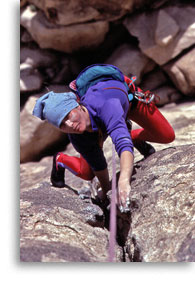
|
|
Fitness is always an asset
|
|
|
|
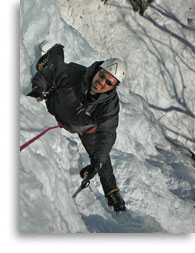
|
|
Flexibility can conserve strength
|
|
Flexibility
Flexibility is the foundation of all fitness. Without flexibility, it is not possible to exploit other aspects of your fitness. A flexible body is also less likely to sustain injury. Some people are naturally quite flexible – others will have to work at it – but all bodies benefit from being supple.
Training Suggestions: A regular, gentle stretching program is the only sensible choice. Aggressive stretching, especially if your muscles are not warmed up, is a great way to injure yourself. You should stretch at the end of every workout, and it’s a good idea to warm up and stretch before as well. Bob Anderson’s book “Stretching” is a great source of information. Yoga, dance, Pilates and other disciplines can offer you a more structured environment.
|
|
Strength
Although good technique will minimize your need for strength, being strong never hurts. Climbers will find strong calves, hands and arms to be a useful asset. Strong thighs make skiing much more fun. To help avoid injury, it is important that the strength of opposing muscle groups be balanced.
Training Suggestions: Your goal should be to develop lean muscles, not the bulky bulges sought by body-builders. In general, this involves training with more repetitions of lighter weights. You can work on individual muscle groups, using machines and free-weights, or specific exercises like pull-ups and dips. Strength-specific training is most conveniently accomplished in a gym or health club. By the way, if you have access to a local climbing wall, boulders, or even a rock retaining wall, you can work on climbing-specific muscles while actually climbing.
|
|
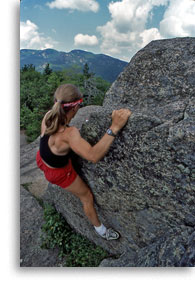
|
|
Bouldering builds strength
|
|
|
|
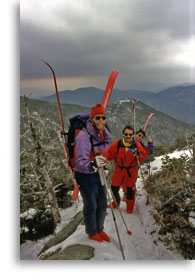
|
|
The best kind of training
|
|
Aerobic Conditioning
Aerobic conditioning will have a much greater impact on mountaineering and skiing than it will on rock or ice climbing, but it’s important in an overall fitness plan nonetheless. If moderate activity (climbing a couple flights of stairs) leaves you winded, you will find aerobic training to be of significant benefit in the mountains.
Training Suggestions: Running, biking, swimming and skiing are all effective training. So is fast hiking, especially if you incorporate hills. Put a pack on your back and go for regular brisk hikes and you’ll build strength, stamina and aerobic fitness together.
|
|
Power To Weight Ratio
No matter how strong you are, excess weight will always work against you. A few extra pounds won’t make much difference but, if you are more than 20% over your ideal weight, you will reap major rewards by losing some weight.
Training Suggestions: Active strength and aerobic training will help you burn calories but you may also need to limit your calorie consumption. Visit a professional dietician if you really have trouble.
A Confession
We do a lot of climbing and skiing, but not much training. If you climb and ski enough you won’t need, or have time, to train! We could certainly improve our fitness by training more, but that would cut into our climbing and skiing time, which is the whole point of training anyway!
Another Confession
For several years our regular massages with Kelly Hass, at Adirondack Therapeutics, (518) 891-2888, have helped protect our bodies from the effects of our rugged lifestyle. You might wish to take advantage of her expertise while you are in our area.
|
|
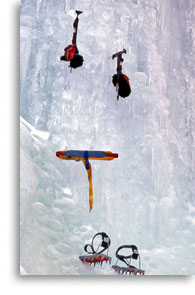
|
|
Thin dude:
taking weight loss too far!
|
|
 |
 |
 |
 |
|
